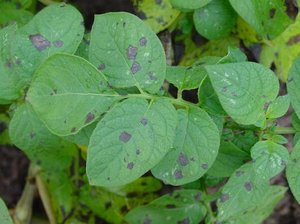What are the problems?

Early blight on potato is a worldwide problem and is, at least in Europe, considered to be caused by the plant-pathogenic fungus Alternaria solani. The pathogenic status of Alternaria alternata is currently under debate, where various groups within EuroBlight report both negative and positive inoculation studies with the fungus on potato. Within Europe, there is a variation in disease incidence. In the Netherlands and Belgium, for example, incidence is fairly low whereas in southern Germany and southern Scandinavia the disease incidence is high enough for field trials not to have to be inoculated. In recent years early blight has become more prominent leading to increased interest and the formation of an early blight subgroup within the EuroBlight network.
The early blight subgroup within EuroBlight aims to collaborate on the exchange of knowledge and ideas in order to fight the disease.
Diagnostics of early blight is a point of interest. It can be done either through growth on agar plates with identification by the developed spores or through PCR. Both methods have their pros and cons and variation among protocols exists between groups working on early blight.
The symptoms of early blight on potato leaves are dark lesions with concentric circles often limited by the leaf veins. The infection often starts on the lower leaves with soilborne inoculums but can spread to other plants through the air, causing premature wilting. Diseased leaves remain attached to the stem. In this way the disease decreases the green leaf area, resulting in reduction in both net yield and starch content. Additionally, toxins released by the fungus also interfere with optimal production of the plant, creating a necessity for the farmer to fight the disease when it is found. Symptoms of early blight in the field are often confused with physiological damage caused by ozone or nutrient deficiencies.
Tuber infections with Alternaria solani can appear as well, but are relatively rare. The disease enters through damaged parts of the tubers where it develops dark, slightly sunken lesions that expand during storage. The lesions often have a raised edge and the tissue beneath the lesions is brown, dry and tough. The symptoms resemble the ones caused by the Tobacco Necrotic Virus (ABC-disease).
Diagnostics is also the basis for control. Current control of early blight is based on strobilurins, but mancozeb, a late blight-fungicide, has a side-effect on early blight as well. Due to the single-site nature of strobilurins, resistance of various pathogens towards the fungicide has been reported. So far, early blight has been controlled without problems by strobilurins in Europe. However, strobilurin fungicides have been reported to show a reduced efficacy against species of Alternaria in some parts of the USA. The tolerance toward strobilurins is caused by three different nucleotide substitutions in the amino acid at position 129 (referred to as F129L) in the gene encoding cytochrome b, the target of strobilurins.
Recently, it has been discovered that there are two types of A. solani in Europe, genotype 1 (GI) and genotype 2 (GII). The latter one resembles the American population and can only be analysed with special primers developed by Pasche et al. (2005). Some of the analysed samples from Germany possessed the F129L substitution in the gene encoding cytochrome b. In Sweden, genotype II has been commonly found and the abundance of F129L is approximately half of the population. However, so far a link between the occurrence of the F129L mutation and reduced efficacy in practice has not yet been seen in Europe and remains an ongoing field of investigation.
While few decision support systems for early blight are currently under development, new insights into the epidemiology, diagnostics and fungicide management create a need for renewed research in this area.
